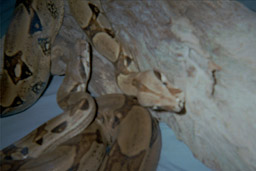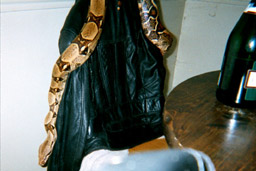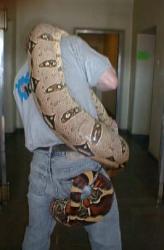|
|
|
 |
RED TAIL BOAS |  |
|
RED TAIL BOA CARE!!! |
||
|
Red Tailed Boas, or Common Boas (Boa constrictor imperator) are often farmed in Columbia, but most true red tailed boas (Boa constrictor constrictor) come from the Amazon and Orinoco River basins of Northern South America. These boas can grow large, often 8-10 feet as adults, with some specimans reaching 12 feet long. Most are tan with darker colored saddles along the body, ending with the trademark red tail. Most say depending on which part of South America they come from, ie. Peru, Suriname, the redder the tail. They are live bearers (giving live birth where pythons lay eggs). Handled often as babies and juveniles, these snakes are usually easy to handle. Keeping in mind that red tails get large as adults, you can start your baby in a 20 gallon long, but will have to upgrade to a bigger tank as your snake grows. We house one adult red tail boa in a 75 gallon tank, and the other adult in a 65 gallon tank. Our baby red tail is in a 20 gallon long tank. You can use various substrates such as wood chips (NEVER cedar as it is VERY toxic to snakes), astro turf carpet, paper towels or newspaper. Newspaper is very easy to clean up and cheap too!! If you choose such substrate as Aspen bedding, its best to feed your boa in a different tank. This reduces the possibility of the snake swallowing the bedding accidently. The tank needs to have a warm side and a cool side so the snake can regulate its body temperature. A heat pad underneath the tank is good and most boa owners use these. Heat lamps are also a good choice Never use a heat rock as the snake can rest against it and burn itself. Make sure you have a water bowl. Red Tail boas LOVE the water and ours soak frequently. Make sure the water level isn't too high, or your boa will overflow the bowl when he gets in. Be warned also, that boas will defecate in the water bowl and it will need to be cleaned and disinfected. A hide box is essential. Some people have 2 hide boxes, one on either side of the tank, but mine seem fine with just one hide box. Your choice. You can find several types of hide boxes. I use the half logs, but you can make your own out of rocks, or tupperware, even upside down terra cotta pots. They will be less stressed if they can hide. I keep climbing branches in there as well, as boas like to climb. Make sure you clean out the tank on a regular basis. I clean the astro turf with hot water and bleach, rinse well and let air dry. I wipe down the tank with the same bleach water solution, rinsing well. Your red tail boa will be more healthier if he doesn't have a smelly, wet, dirty tank to live in. Add a thermometer inside the tank to monitor the temperatures. Temperatures should be kept anywhere between 80-92 degrees on the warm side during the day and about 75-80 degrees at night. Don't let the temperature get below 70 degrees. |
||
 these were our first two red tails, Sebastian (On right, who passed away) and Azriel. Both were about 6 feet long in this photo. |
||
|
Offer your baby red tails a pinkie mouse or a fuzzy every few days. Babies are growing so they will eat more at first. Older boas, at about 1 and a half feet long should get mice, then eventually rats. Our adult red tail boa gets a medium rat every other week, and our baby get a mouse or two every 7 days. Full grown red tails can usually get large rats also, depending on the size your snake will get. Try to get them on a schedule. DO NOT put your hands inside the tank when your boa is eating, or is about to feed. You may get bit if your snake sees your hand first and thinks it's his dinner. Wash your hands before and after feeding. If you still smell like a rodent, he will treat you like a rodent!! There is always debate on whether to feed live mice and rats, or pre-killed frozen. If you choose to feed live, please monitor the feeding carefully. Invest in a pair of hemostats just in case you need to separate the rodent from the snake if it is biting. All of our snakes eat live rodents and we use caution and monitor all feedings. You can also stun the rodent before dropping it into the tank. A rat could bite your snake defensively as it is getting squeezed. If you think that happened, check the boas skin for red, open marks and make sure they are cleaned. Infection could set in. I have seen damage to a snakes skin from untreated bite wounds and it isn't pretty. Usually neosporin on the bite will help and after a few sheds, the scar won't be that noticable IF treated immediately. After your boa eats, leave it alone. Often if you try to handle the snake, there's a chance it could regurgitate its food. It usually will take a few days if the temperatures are right for it to digest. I don't handle mine until after they defecate. That way I know they are digested, and I can handle them for a few days until the feeding begins again. When the boas eyes turn a milky blue color, that means they are getting ready to shed their old skin. They will dull to a dark color and will not take offered food. In a few days, the eyes will clear up and after a few more days he will rub its nose against things to break the skin. Then it will crawl out of the old skin and you have a shiny, smooth beautiful snake. Offer it food after it sheds. If they do not shed in one piece, check the humidity levels. Red tails are tropical, so make sure the humidity is high, maybe 70%. Mist the tank and the snake. Soaking it in warm water helps too. When handling your snake, make sure you support the thickest part of his body, and don't squeeze too tight. Your boa will be curious and will want to explore. With any snake over 8-9 feet long, two people should be present to handle the snake properly. They like warm dark places. Avoid any sudden, jerky movements around their head. Snakes can strike and bite if they feel very threatened. Make any movements around him slow and careful. Some owners will not let too many people handle their snakes, where other owners won't mind passing their boa around. I tend to make sure a few people who have handles snakes before and who are not frightened of them, hold mine. It won't stress your snake out that way. I handle mine a few times a week, mostly before their next feeding, for about a half hour at a time. As long as your boa seems to enjoy being handled by you, both you and he should be fine. If you do ever get bitten by your boa, make sure there is no teeth embedded in your skin and clean well with peroxcide and neosporin. Most times a boa will bite if hungry and mistakes you for food or out of fear. Don't be afraid to handle him after a bite. You need to make sure he didn't lose any teeth which can happen if you jerk your hand when you are bitten. It can get infected and might lead to mouth rot. Remember that red tails are larger than ball pythons, so the bite will be bigger!! Boas have many many teeth, and the bite will bleed A LOT! Red Tail Boas and other snakes can get sick. If the cage is dirty, too cold,or if the humidity levels are off. Improper temperatures can also cause your boa to not eat. They can get mouth rot, respitory infections,internal parasites, mites, ticks and inclusion body disease (IBD) which is very serious and deadly. If you think your snake is sick, the first thing to do is raise the temperature in the cage to almost 90 degrees. This will alleviate some of the symptoms and your best bet is a trip to the vet. It's been known that elevated temperatures help the snake. Mites are tiny little parasites that feed off of the snakes blood. It is a huge pain to get rid of them, as it entails treating the snake, the tank, the branches, water bowls, hide boxes. Another treatment or two after that will kill the eggs. Left untreated, mites can cause plenty of damage and sometimes death. Check the water when your snake gets out. You will see little black dots, like pepper, floating in the water. Good sign that mites have infected his happy little home. Good page on mite prevention by Melissa Kaplan on my links page. **NOTE** If you suspect your boa is sick, take him in to a good herp vet ASAP. Some conditions, like internal parasites and respitory infections will need medication to cure. Responsibility is the key here, be prepared for any emergencies by having a qualified herp vet on hand. |
||
 Sebastian |
||
 This is a HUGE Peruvian Red Tailed Boa. Good example of the massive size they can get. |
||